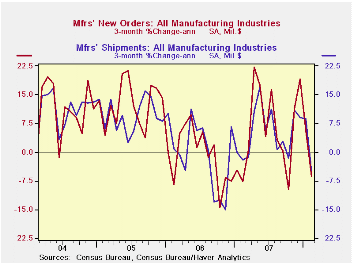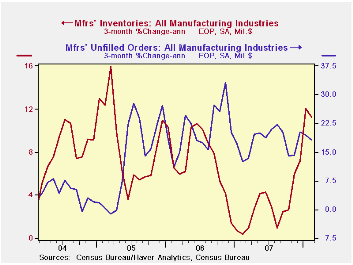 Global| Apr 02 2008
Global| Apr 02 2008U.S. Factory Inventory Rise Continued Firm
by:Tom Moeller
|in:Economy in Brief
Summary
Factory inventories rose 0.5% in February, down from the 1.3% surge during January. Despite the lesser rate of monthly gain, the three month growth in inventories jumped to 11.3% (AR) which was near its strongest since early 2005. [...]

Factory inventories rose 0.5% in February, down from the 1.3% surge during January. Despite the lesser rate of monthly gain, the three month growth in inventories jumped to 11.3% (AR) which was near its strongest since early 2005.
Strength within the transportation sector accounts for some of that lift. The aircraft industry is having an outsized effect and inventories there rose 1.4% in February following a 3.7% January surge, and three month growth is at 39.2% (AR). But still showing strength were inventories excluding the transportation sector. They rose 0.4% in February and three month growth rose to 9.5% after no gain early last year. Inventories of machinery, computers & electronics and electrical equipment & appliances are growing more rapidly. 
With a 2.1% decline, factory shipments took back all of January's 1.1% jump. Excluding the transportation sector the numbers were as bleak and shipments fell 1.8% after just a 0.8% January increase.Three month growth turned to a negative 4.8% which was the weakest since late 2006. It reflected declines in textiles, apparel, computers and furniture.
Total factory orders fell another 1.3% during February. Less the transportation sector altogether orders fell a larger 1.8%. Durable orders overall fell 1.1% and that was slightly less than the 1.7% decline reported in the advance report. Nevertheless, the three month rate of change fell to -0.4% and less transportation the three month change in orders was a negative 6.4%. Nondurable orders (which equal shipments) fell at a 7.4% rate.
Overall unfilled orders rose 0.9% in February and the three month rate of increase continued very strong at 18.2%. Shipments of civilian aircraft & parts couldn't keep pace with orders, so unfilled orders rose. Excluding the transportation sector altogether unfilled orders fell 0.1% m/m and the three month average growth rate fell to a still firm 8.4% (AR).
| Factory Survey (NAICS, %) | February | January | Y/Y | 2007 | 2006 | 2005 |
|---|---|---|---|---|---|---|
| Inventories | 0.5 | 1.3 | 5.5 | 3.7 | 6.4 | 8.9 |
| Excluding Transportation | 0.4 | 1.3 | 4.5 | 2.5 | 7.1 | 8.0 |
| New Orders | -1.3 | -2.3 | 6.0 | 1.4 | 5.1 | 11.6 |
| Excluding Transportation | -1.8 | -0.3 | 6.1 | 1.2 | 5.4 | 11.5 |
| Shipments | -2.1 | 1.1 | 5.5 | 1.1 | 4.3 | 10.3 |
| Excluding Transportation | -1.8 | 0.8 | 6.5 | 1.3 | 5.0 | 11.4 |
| Unfilled Orders | 0.9 | 0.8 | 18.6 | 18.1 | 20.0 | 15.0 |
| Excluding Transportation | -0.1 | 0.8 | 8.5 | 9.1 | 14.1 | 8.4 |
Tom Moeller
AuthorMore in Author Profile »Prior to joining Haver Analytics in 2000, Mr. Moeller worked as the Economist at Chancellor Capital Management from 1985 to 1999. There, he developed comprehensive economic forecasts and interpreted economic data for equity and fixed income portfolio managers. Also at Chancellor, Mr. Moeller worked as an equity analyst and was responsible for researching and rating companies in the economically sensitive automobile and housing industries for investment in Chancellor’s equity portfolio. Prior to joining Chancellor, Mr. Moeller was an Economist at Citibank from 1979 to 1984. He also analyzed pricing behavior in the metals industry for the Council on Wage and Price Stability in Washington, D.C. In 1999, Mr. Moeller received the award for most accurate forecast from the Forecasters' Club of New York. From 1990 to 1992 he was President of the New York Association for Business Economists. Mr. Moeller earned an M.B.A. in Finance from Fordham University, where he graduated in 1987. He holds a Bachelor of Arts in Economics from George Washington University.






